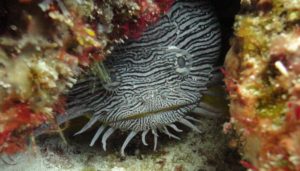There are many reasons to dive Cozumel — healthy coral, easy, fun drift dives, after-dive margaritas. But a chance to spot the endemic splendid toadfish is one of the most compelling.
What is a splendid toadfish?
Starting in the early 1980s, a certain set of car enthusiasts began attaching LED lights to the chassis of their mostly low-rider cars, bathing the ground beneath in blue, red, green, or purple. Called “underglow,” the overall effect, depending on who you ask, was either of a car swept along on magic carpet of neon or of tacky disco lights hitching a ride on the undercarriage. It’s possible that the splendid toadfish inspired these pioneers of automotive showmanship with its unique yellow underglow, which has earned it a spot on many divers’ bucket lists. And, like a supermodel who can wear anything, the sanopus splendidus pulls off the look.
An ambush predator, the splendid toadfish sits on pelvic fins with only its outsized head  poking out from the rocky crevices that serve as its den. It lies in wait for small fish, worms and other prey to swim by. Its face is striped like a zebra and barbells hang like icicles off its chin. Splendid toadfish have eight fins in total: two dorsal fins, two pectoral, two pelvic, a caudal fin and an anal fin. But its most striking features are the wide, electric-yellow bands that line these fins and the inside of its mouth.
poking out from the rocky crevices that serve as its den. It lies in wait for small fish, worms and other prey to swim by. Its face is striped like a zebra and barbells hang like icicles off its chin. Splendid toadfish have eight fins in total: two dorsal fins, two pectoral, two pelvic, a caudal fin and an anal fin. But its most striking features are the wide, electric-yellow bands that line these fins and the inside of its mouth.
The species has a total of eight fins; two dorsal fins, two pectoral fins, two pelvic fins, a caudal fin and an anal fin. The midline of the upper body contains the two dorsal fins; a short fin with sharp spines in 3 spots and a long fin which extends over much of the upper body and is flowing.
Where does the splendid toadfish live?
 The sanopus splendidus is endemic to Cozumel, a popular island-diving destination off the coast of Playa del Carmen in Mexico. That said, recently some divers have reported spotting them along the Belize barrier reef. Their rarity, the relatively shallow (32 to 60 feet or 10 to 18 meters) habitat they prefer, and Cozumel’s clear waters combine to make the splendid toadfish a subject prized by underwater photographers and recreational divers alike.
The sanopus splendidus is endemic to Cozumel, a popular island-diving destination off the coast of Playa del Carmen in Mexico. That said, recently some divers have reported spotting them along the Belize barrier reef. Their rarity, the relatively shallow (32 to 60 feet or 10 to 18 meters) habitat they prefer, and Cozumel’s clear waters combine to make the splendid toadfish a subject prized by underwater photographers and recreational divers alike.
To spot them, swim along the edge of shallow reefs that give way to sandy bottoms. The Paradise Reef dive site is a splendid — ahem — example. Peer into any opening, the sort of place you might otherwise find a moray eel. Look for a striped face, bulbous eyes on the forehead, and the signature yellow glow.
Guest author Christina Koukkos is a New York-based freelance writer and editor. She covers scuba diving, responsible tourism, off-beat destinations, cultural travel and other topics. She’s a certified PADI dive instructor and MSDT as well as an amateur underwater (and topside) photographer. Learn more about her on her website, her blog, on Instagram or Twitter.

